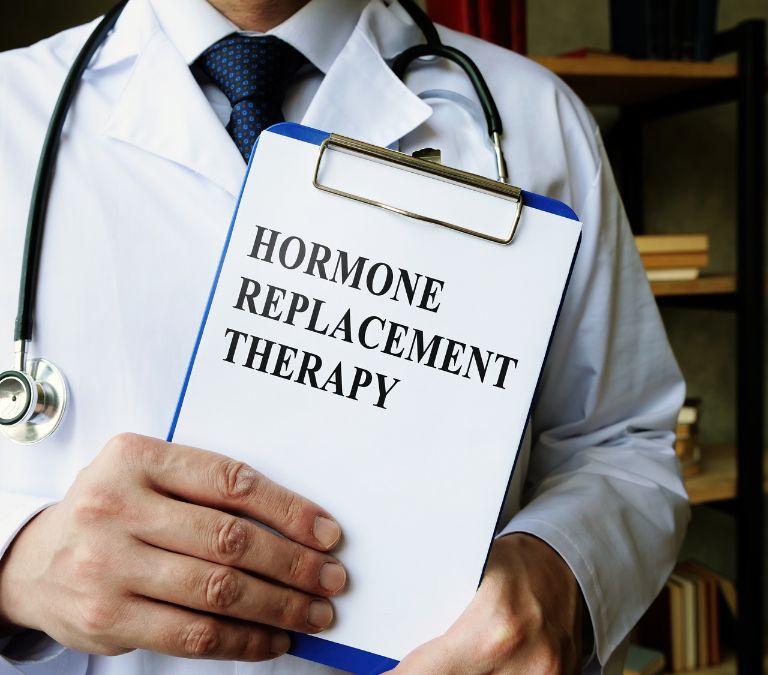Hormone replacement therapy (HRT) is a medication that menopausal women take in other to artificially get female hormones – Estrogen and progesterone which are usually in continuous decline during menopause onset as during menopause, the body finds it difficult to produce these hormones anymore through the natural biological pathways.
Hormone replacement therapy is a common remedy for easing menopausal symptoms like hot flashes, night sweats, and vaginal discomfort; testimonials from menopausal women also prove that HRT is effective in managing bone density loss and fractures. Other menopausal symptoms that HRT can help ease include:
- Cold flashes
- Low Sex drive (low libido).
- Urinary urgency due to dysfunction of the bladder muscles.
- Sleeplessness (insomnia).
- Brain fog, irritability, anxiety and mood swings, and mild depression.
- Scaly and dry skin, eyes and mouth, etc.
- Tooth loss.
- Reduced risk of colon cancer.
- Reduced risk of diabetes.
- Improvement in joint pains.
- A general decrease in the death rate of women undergoing the menopausal transition.
In Hormone replacement therapy (HRT), factors like age, personal medical history, family medical history, the severity of menopausal symptoms, etc., are considered before the type (choice) and dosage of these hormonal medications are administered; and it is advised that the risks and benefits of the available hormonal therapy be discussed with the healthcare personnel(s) before going for any type and dosage.
As earlier stated, hormone replacement therapy (HRT) focuses on augmenting or replacing the levels of estrogen (mostly) and progesterone that the body can no longer produce during pre-menopause or after menopause.
What is Estrogen?
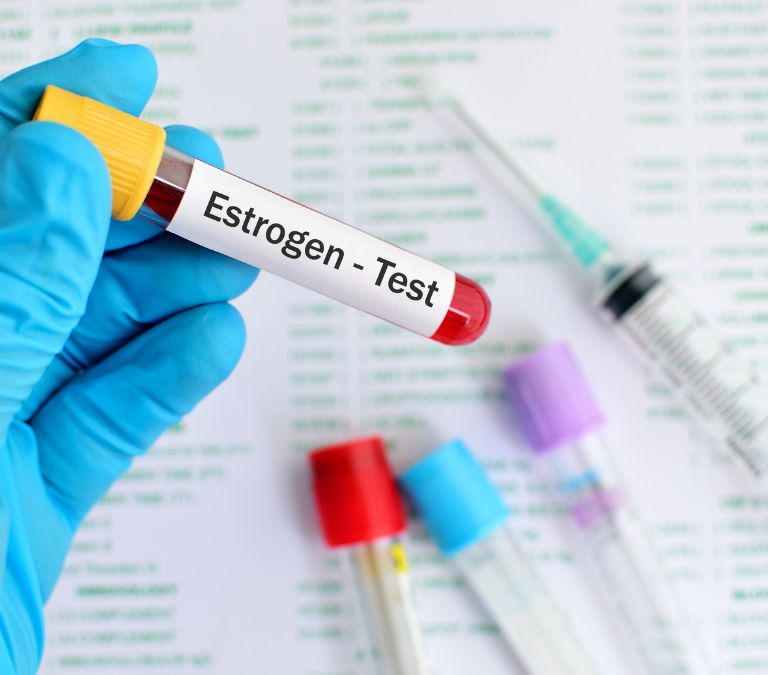
Estrogens are groups of hormones that play vital roles in developing secondary sexual characteristics concerning reproductive development in women; they are otherwise called sex hormones. The ovaries of females of reproductive age make most estrogen hormones, although the adrenal glands of the kidneys’ adrenal cortex and fat cells of adipose tissues also make manageable amounts of the hormones.
What role does estrogen play?
Estrogen plays a major role in many biological processes, especially in reproductive development in females of reproductive age (women); these roles include:
- Thickening of the uterine lining (wall) in readiness for the possible implantation of a fertilized egg during ovulation.
- Influencing the body’s uptake and use of calcium – an essential mineral in bone-building and functions.
- Maintaining healthy levels of blood cholesterol.
- Maintaining the vagina’s health.
- Preventing loss of bone mass (osteoporosis) by making calcium available for uptake.
What is Progesterone?
Progesterone is one of the main pro-gestational steroid hormones secreted by the female reproductive system, particularly the corpus luteum of the ovaries, and is usually linked to menstruation, pregnancy, and fetal development. It is synthetically available as progestin and useful in many medical diagnoses and treatments, like menopause-related Hormone replacement therapy.
What peculiar role does progesterone play?
Progesterone plays vital roles in many body biological processes, which include:
- Preparing the uterus (womb) to implant a fertilized egg(s).
- Maintaining pregnancy and fetal development.
- Regulating the blood pressure.
- Improving and managing mood and sleep.
Why Menopausal women take Hormone Replacement Therapy
Menopausal symptoms can present women going through a menopausal transition with great discomfort and restlessness, and the psychological impact of always feeling sickly and not being able to explain their body system anymore is always the propelling force why they seek refuge in taking hormone replacement therapy as a remedy to get at least some easing for the menopausal symptoms.
And thus, benefits derived from hormone replacement therapy are always the push for menopausal women against the slight risk accompanying different types of hormone replacement therapy.
Below are some of the reasons (benefits) why women take hormone replacement therapy: –
-
Managing and easing mild and intense hot flashes:- according to reports, systemic estrogen therapy is a very effective management and ease of problematic menopausal symptoms like night sweat and hot flashes.
-
Easing and management of other menopausal symptoms: – Estrogen can also ease other menopausal symptoms like as vaginal dryness, vaginal itching, burning sensation, and low sex derived from discomfort in the vagina due to dryness.
-
Prevention of bone density loss and breakage: – Estrogen therapy taken directly into the blood stream also protects the bone mass of menopausal women against bone-thinning and loss of mass – a disease known as osteoporosis.
-
Managing premature menopause and/or having estrogen deficiency:- hormone replacement therapy, especially estrogen, always serve as a relief for women who are experiencing earlier menopause, probably due to the surgical removal of ovaries due to one condition or the other before the age of 40, and invariably stopped menstruating before 40 years (premature menopause) or when the ovaries become dysfunctional and have lost normal functions by late 30s (usually referred to as primary ovarian insufficiency), during which the body has been exposed to too little estrogen level as even sometimes far less than the levels produced by bodies of menopausal women.
Types of hormone replacement therapy (HRT)
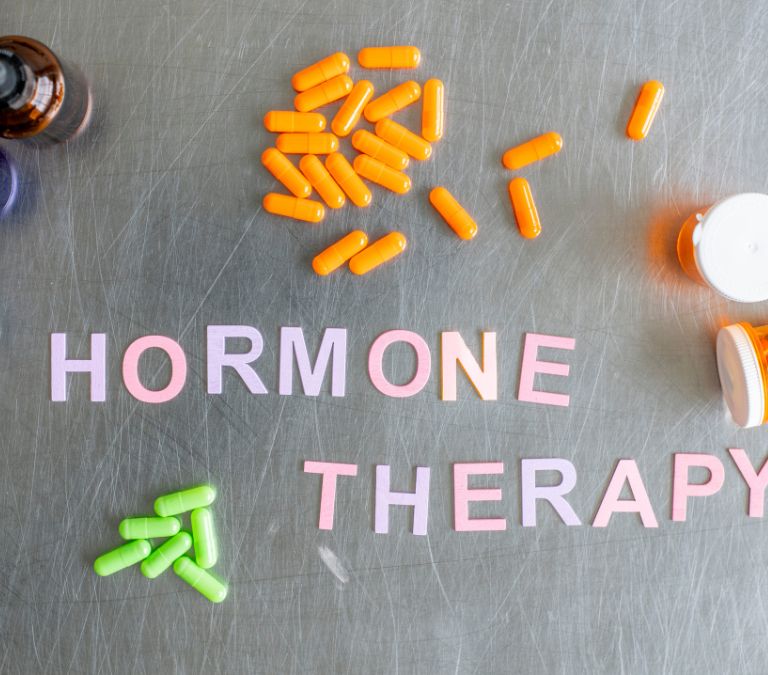
There are three (3) main types of hormone therapy (HT) available for menopausal women; they include:-
- Estrogen Therapy: – Estrogen can be taken alone or combined. Healthcare practitioners often prescribe a low dose of estrogen as pills or patches daily, such as a tropical cream, vaginal ring, vaginal gel, or vaginal spray. Menopausal women are advised always go for the lowest dose of estrogen to relieve menopause symptoms. Estrogen therapy is also a good relief for women experiencing early menopause after surgical removal of the womb (hysterectomy) and bilateral saphingoophorectomy alongside hysterectomy (surgical removal of the ovaries, fallopian tubes, and the uterus) such that the ovaries are no longer there or now dysfunctional in producing the natural estrogen.
As stated earlier, estrogen hormone therapy comes in different forms: pills, patches, vaginal rings, vaginal creams, and topical gels.
- Estrogen pill:- Pills are the most commonly used estrogen hormone therapy for menopause and related symptoms. There are two main forms of this estrogen pill available: conjugated estrogens orals like Estratab, Cenestin, Premarin, Estrace, Ogen, Femtrace, etc., and estrogens-bazedoxifene orals like Duavee, etc.
Menopausal women taking estrogen pills options are advised to adhere to the doctors’ instructions on dosing as most estrogen pills are to be taken daily without food, while other forms have more complicated dosing schedules.
- Estrogen patch:- The estrogen patches are usually worn on the skin of the abdomen. Depending on the prescribed dosage, some patches are replaced every 2- 3 days, while others can be worn longer, up to a week. Estraderm, Climara, Viville-dot, menostar, and Alora are examples of these estrogen patches. Other estrogen patches are in combination form – Estrogen and progestin patches, e.g., Combipatch and Climara Pro.
Menostar has a normal estrogen patch with a lower, if not the lowest, dose of estrogen than other patches, and it’s only effective in reducing the risk of osteoporosis (loss of bone mass and fracture) and does not ease or manage other menopausal symptoms.
- Topical estrogen:- Synthetic estrogens in creams, gels, and sprays form and offer another route of obtaining estrogen into the systems of menopausal women. Topical estrogen includes gels – Divigel and EstroGel; sprays – Evamist and Evamistcreams, e.g., Estrasorb.
Just like patches, this type of estrogen hormone treatment is also absorbed through the skin route directly into the bloodstream, and the directives on how to apply these creams vary depending on the concentration of the active ingredient and manufacturers’ information, although most topical estrogen is usually used once a daily. Topical EstroGel is usually applied on one arm, from the wrist to the shoulder, topical Estrasorb is applied to the legs, and topical Evamist is applied to the arm.
- Vaginal estrogen: – Topical Vaginal estrogens are available in cream forms and vaginal rings, and then vaginal estrogen tablets. Generally, these estrogen treatments are for women going through menopause transition who are troubled specifically by vaginal itchiness, burning sensation, and dryness pain during intercourse. These vaginal estrogen therapies include tablets like Vagifem, creams, e.g., Premarin or Estrace, insert- able rings like Femring or Estring.
Just like other estrogen therapy forms, vaginal estrogens also follow dosing schedules, which may vary based on the doctors’ prescription and manufacturers’ information on the product (s). Most vaginal rings are to be replaced every three months for safety reasons; the vaginal estro-tablets are used daily for only a couple of weeks, after which the dosing becomes just twice a week, while the vaginal topical creams may be used daily; many times a week, or according to a different schedule.
Pros of Estrogen Therapy
Estrogen is known for its vital role in the reproductive system. According to research, it also helps almost every organ system of the body, especially in a woman. Below are a few of the core roles of biological estrogen and the same role estrogen therapy tends to mimic.
- Protection of the heart and improving the heart functions
Estrogen is great for the heart by keeping the heart tissue healthy and also helps with keeping the blood pressure stable.
Therefore, when the estrogen levels are high, it helps manage and keep blood triglycerides low, increases high-density lipoproteins (HDL) cholesterol, and keeps low-density lipoprotein (LDL).
Although the link between estrogen and the heart is still under serious research, for instance, recent studies have it that the risk of developing cardiovascular disease is high for individuals who had undergone bilateral oophorectomy (the surgical removal of both ovaries and fallopian tubes) before menopause.
- Brain Protection
Both the natural and artificial estrogen (estrogen therapy) roles are well associated with the brain as it protects the brain by ensuring and maintaining proper blood flow through to the brain.
Estrogen also protects against inflammation of the brain cells due to oxidative stress and disease, assisting greatly with memory and fine motor skills improvement, especially in stroke management.
Estrogen role as mentioned earlier in brain protection explains why estrogen is very effective in managing brain fog as one of the symptoms of menopause.
A study shows that the more an individual has been exposed to estrogen, whether natural or artificial, the healthier and better their brain health is as they age.
- Improving the muscle mass and bone density
The estrogen hormone plays vital roles in the growth of the bone cells and improving muscle mass, explaining its effectiveness in managing osteoporosis – a health condition in which bones become weak and brittle due to loss of cells and loss of bone mass, predisposing the bone to fracture any slightest accident.
During the menopausal transition, bone mass readily decreases with the decrease in estrogen level, further confirming estrogen’s vital role in bone and muscle maintenance and why estrogen therapy is generally embraced by menopausal women in managing osteoporosis – one of the troublous symptoms of menopause.
- Managing Anxiety and Boosting the mood
Mood swings during menstruation and the notable anxiety and depression occurring during menopause are said to be due to the fluctuating and decreasing levels of estrogen, respectively; as the hormone – Estrogen is known as a trigger for the secretion of serotonin (the feel-good hormone) and the sister endorphins that together help in nerve functions and growth; and muscle relaxation.
- Improving sex drive
Estrogen is very important when improving and maintaining healthy sex life, especially in women, by keeping the vagina lubricated; as estrogen level has a very close link with vagina lubrication because studies have confirmed that when estrogen levels become too low; the vaginal walls become thinned and produces less lubrication and vise versa.
The above reason explains the loss of elasticity of the vaginal walls and the subsequent drop in sex drive in women going through the menopausal transition and the reports of painful sex, and thus, the relief that topical vaginal cream estrogen therapy and the likes give to menopausal women.
Cons of Estrogen Therapy
Estrogen hormone therapy has some side effects; although not to be compared to its benefits, it is also good to know the counter effects before going for estrogen hormone therapy. These side effects include:
- vaginal bleeding
- Swelling in other body parts (Face, legs, etc.)
- Swelling and tenderness of the breast
- indigestion
- Headaches (Slight and sometimes serious)
- a feeling of being unwell
- Cramps in leg
- Bloating (gas in the stomach)
- Estrogen Progesterone Hormone Therapy (EPT):- a hormone replacement combination therapy that is a combined dosage form of estrogen and progestin (synthesized progesterone); the reason is also referred to as estrogen-progestin therapy.
EPT is usually best recommended for women undergoing menopausal transition whose uterus is still intact, as this combination therapy reduces the risks of endometrial and uterine cancers compared to only estrogen therapy.
Although progesterone is generally used for birth control, it is effective in easing and managing menopausal symptoms like hot flashes and night sweats.
Estrogen-progesterone/Progestin Therapy can be administered in two forms:
- Oral progestins, and
- Intrauterine Progestins
- Progestin Patches
- Oral progestins:- these forms of EPT are taken orally as medications and pills. The oral EPT includes progestin medications like Provera (medroxyprogesterone acetate) and the progestin pills like norethindrone, norgestrel, Bijuva, Angeli, Prempro, etc.
Many healthcare experts now manage most menopausal symptoms with organic progesterone rather than synthesized progestins. According to research, organic progesterone is indirectly associated with lipids and thus helps to manage high cholesterol levels in menopausal women compared to its synthetic form – progestin.
- Intrauterine progestin:- This form of EPT comes as a Low-dose intrauterine device (IUD) and, as the name implies, is administered to the walls of the uterus. IUDs are available as levonorgestrel, a trademarked name, and sold under the following brand names – Skyla, Liletta, Mirena, and Kyleena.
Intrauterine devices are approved for family planning and bleeding control in the USA and are sometimes administered “off-label” with estrogen. Women with the IUD implants are advised not to remove them even during menopause transition until after transition has been completed as it helps irregularities in menstrual cycles in the premenopausal stage and easing of menopausal symptoms when menopause has fully set in.
Progestin Patches include:- Combipatch, Climara-pro, etc.
Benefits of EPT
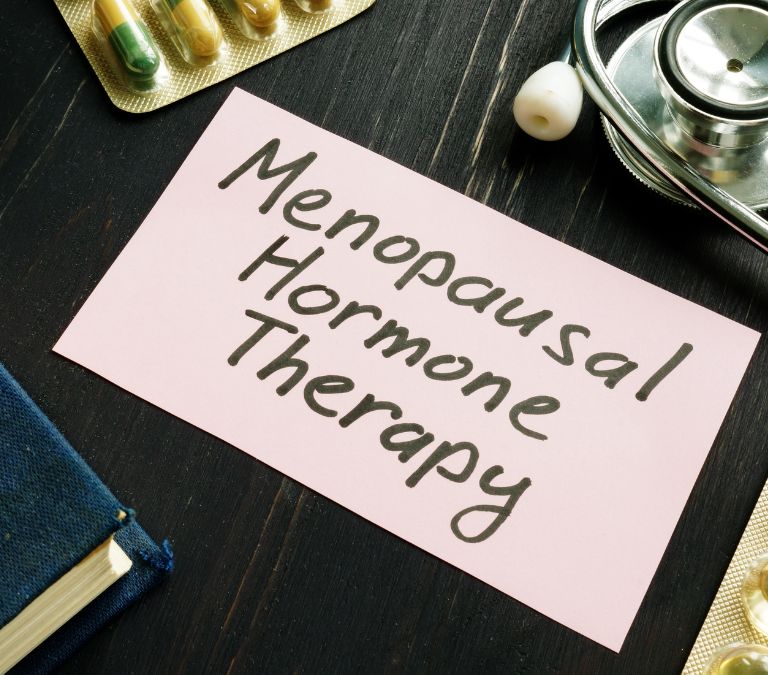
The EP hormone combination therapy serves a dual benefit as it combines the benefit of estrogen, as already discussed above, and that of progesterone which involves blood pressure regulation and mood improvement, among many others already discussed earlier.
Disadvantages or side effects of Estrogen-progesterone (progestogen) hormone therapy
Below are some side effects of using the EP combination therapy; although these side effects cannot be equated to the great benefits reported by menopausal women on the use of this remedy; and as well differs for each person depending on the individual body’s reactions and acceptance of the therapy:
- Abdominal upset
- acne
- breast tenderness
- depression
- Migraines
- mood swings
- pain in the lower back
- swelling in other parts of the body
- vaginal bleeding
- Vaginal dehydroepiandrosterone (DHEA) Hormone Therapy:- also known as prasterone vaginal therapy. Prasterone is the synthetic form of a hormone known as dehydroepiandrosterone (DHEA) which is normally secreted by the adrenal gland of the kidneys and on its own inactive until it is converted to estrogen and androgen, which are active sex hormones.
Vaginal dehydroepiandrosterone HT is usually in the form of vaginal inserts; a commonly known brand is Intrarosa.
Is menopausal Hormone Replacement Therapy expensive?
One of the top questions most menopausal women seeking hormone replacement therapy ask first is what the overall cost of hormone therapy treatment, as much as this is an honest inquiry from a place of sincere concern as most insurance plans do not cover the cost of such treatment, it is still a factual matter that HRT is one of the most affordable treatments for menopausal symptoms.
According to research, the average cost of hormone replacement therapy is 30 – 90 USD per month. And thus, the cost of individual treatment within this new range will depend on other factors like dosage, treatment type, and choice; and if there is any other underlying health condition to be treated alongside.
Other reasons for Hormone Replacement Therapy to save cost
As already stated about the significantly lowered cost of this treatment as against other treatment methods like surgeries and other medications; there are many other ways this treatment helps in saving cost, and they are:
- Curtailing and curbing Spending on Other Medications
Going for hormone replacement therapy helps curb the use of other medications in managing menopausal symptoms like buying sex enhancement medications when trying to manage low sex drive.
- Drastic reduction in the Cost of Other Therapies
Using almost the same cost budget to get hormone therapy will help address all the symptoms that other therapies like bone surgeries and the like would have cost, and invariably lowering cost or co-pay is required for these other therapies.
- Spend Less on Lifestyle Costs
Financing a lifestyle and using dieting for remedying menopausal symptoms is not always a walk-in-the-park cost-wise, so hormone replacement therapy is always handy and is typically powerful enough to reduce or not totally eradicate the need for other non-medical treatments.
Is Menopausal hormone Therapy safe?
Yes, to an extent, as it presents the body with a lot of benefits when compared with associated risks; which is almost inevitable for most medications, but to be able to measure the level of safety associated with hormone therapy as most of the benefits have been earlier analyzed, the associated risks will have to be demystified as well and then help individuals know how safe it is relatively.
The reports of the latest largest clinical trial showed that hormone replacement therapy which consisted of the combination therapy of estrogen-progestin pill (Prempro), presents the body with an increased risk for certain serious conditions. So while HRT helps many women through the menopause transition, the therapy, like the continuous use of other medications, is not entirely risk-free. These health risks include:
An increased risk of endometrial cancer (when using estrogen therapy alone)
- High risk of blood clots and stroke.
- Increased chances of gallstone and gallbladder dysfunction.
- High risk of dementia Alzheimer’s, especially if HRT was started after age 50.
- High risk of developing breast cancer, especially with long-term use.
- Increased risk of developing cardiovascular dysfunction
- Hormone therapy and heart disease?
- Hormone Therapy and Heart Functions
The effect of Hormone therapy on heart functions and blood vessels has formed a lot of hypothetical questions in recent research studies; but as yet unclear as this course still is, some studies have there are negative effects of general hormone therapy in women who has it used for over 10 years – partially suggesting how long the body can and can no longer support the treatment.
The American Heart Association (AHA) also stated in line with the proposed risk of heart disease with the use of HT, saying that it is recommended to go for HRT to prevent heart diseases, especially stroke and heart attack.
- Hormone therapy and breast cancer
Taking combined therapy of systemic estrogen-progestin as results from studies has linked it closely with an increased risk of developing breast cancer. The findings from the studies show that:
Combining hormone therapy showed a rare increase in absolute risk of less than one additional case of breast cancer per 1000 person-years of use.
There was no significant reduction in breast cancer cases seen in women with had undergone hysterectomy and are on estrogen-only therapy.
Systemic hormone therapy worsens breast cancer complications; thus, chemotherapy for breast cancer cannot go together with systemic hormone therapy.
Other Factors associated with increased risks of Hormone replacement therapy
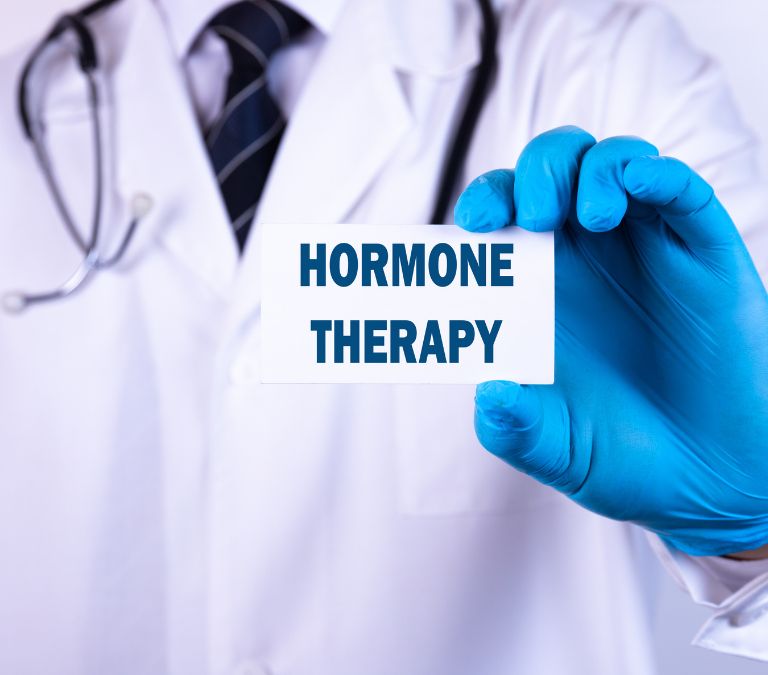
Another study also suggested that reports on these risks and their magnitudes depend on factors like age, medical history, choice, type of hormone therapy, etc.
Age:- Reports have it that women who began hormone therapy 10 years after the menopause begins or after age 60 have greater chances of developing the risks above, and these reports suggest being started before 60 years of age or within the first few years into menopause.
Types of hormone therapy: – The level of hazards connected with hormone therapy also depends on the type and choice of therapy, including whether estrogen is administered alone or in conjunction with progestin and the dose of therapy.
Your Health History:- Family history and individual medical histories, such as whether or not there is a risk of cancer, osteoporosis, diabetes, heart disease, liver inefficiency, stroke, or blood clots, are crucial aspects to consider when deciding whether or not to undergo hormone therapy.
When determining if hormone therapy is possible for you, you and your physician should consider all of these potential adverse effects.
Can everyone go for hormone therapy (HT)?
As earlier discussed, hormone therapy (HT) is not for everyone and is therefore usually not recommended for people who are:
- Have or had cancers of the breast or endometrium.
- Have vaginal bleeding.
- Have had blood clots
- Have a history of stroke or heart attack
- Suspecting to be pregnant or pregnant for sure.
- Have liver disease.
What are the General side effects of hormone therapy (HT)?
Just like other medications, hormone therapy has counter or side effects and the most common these effects reported are:
- Monthly bleeding and Irregular spotting.
- Breast tenderness.
- Mood swings.
- Other less reported side effects of hormone therapy include:
- Fluid retention.
- Headaches (including mild and migraine).
- Skin discoloration (spotting)
- Increase in breast density
- Skin irritation
How long, then, should one take menopausal hormone therapy?
Many women usually stay on the hormone therapy between 2 – 5 years or longer, as the case may be, from the onset of menopause until the menopausal symptoms stop or ease drastically. It is advised that post-menopausal women use the dose-reduction withdrawal method when they are about to stop hormone therapy rather than abruptly stop.
Summarily, Hormone replacement therapy is very beneficial in managing menopausal symptoms, although factors like age, medical history, and suitable choice are to be considered in other to minimize associated risks and side effects; also, hormone therapy should is not a life-long treatment from menopause onset, and attention should be paid after few years using it in other to know when to start withdrawing and eventually stopping.

